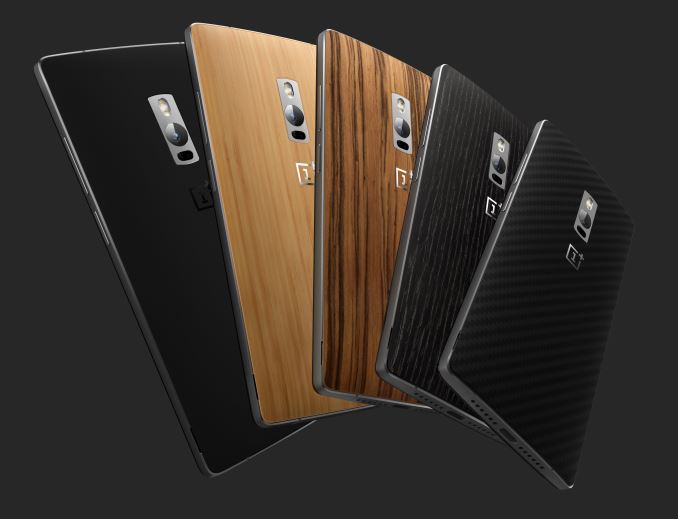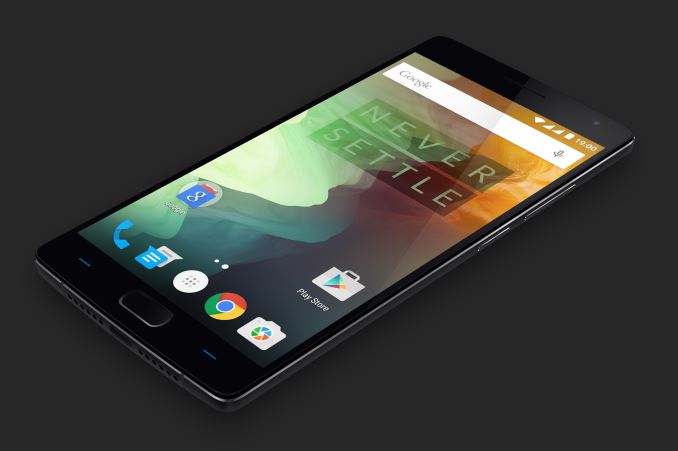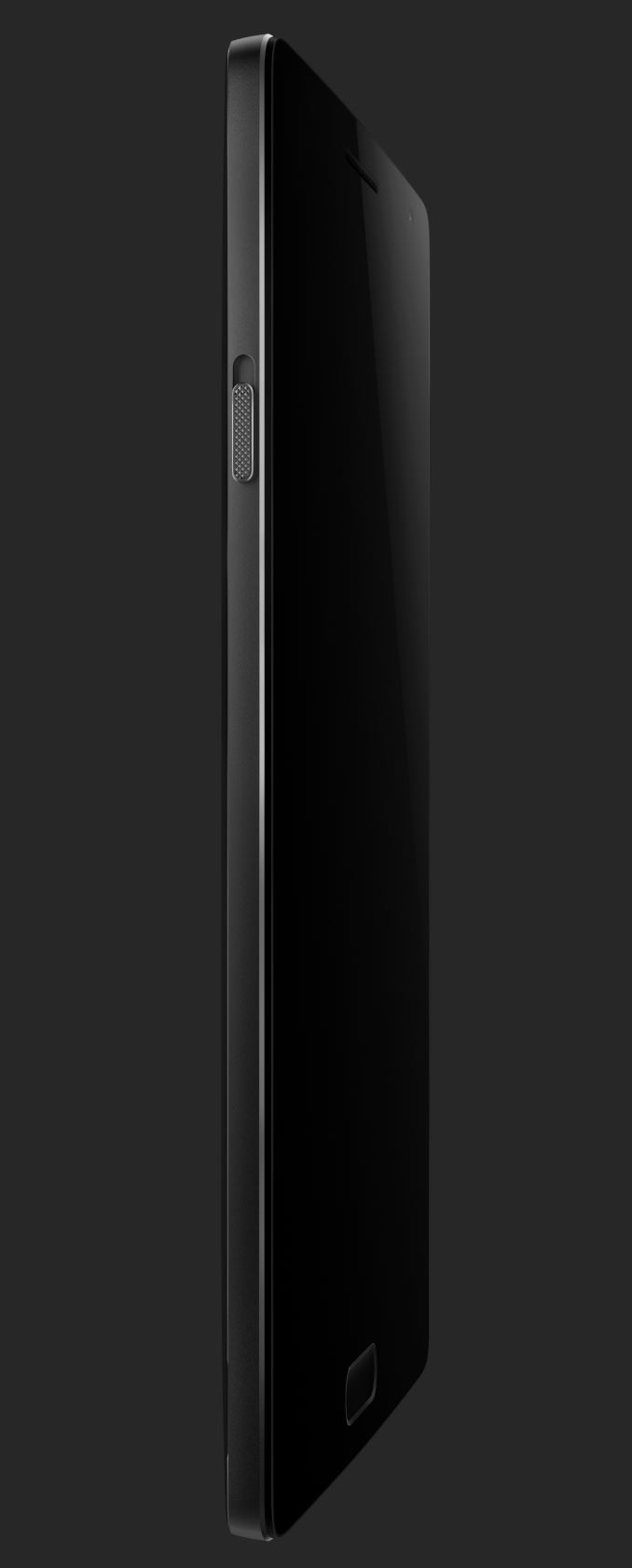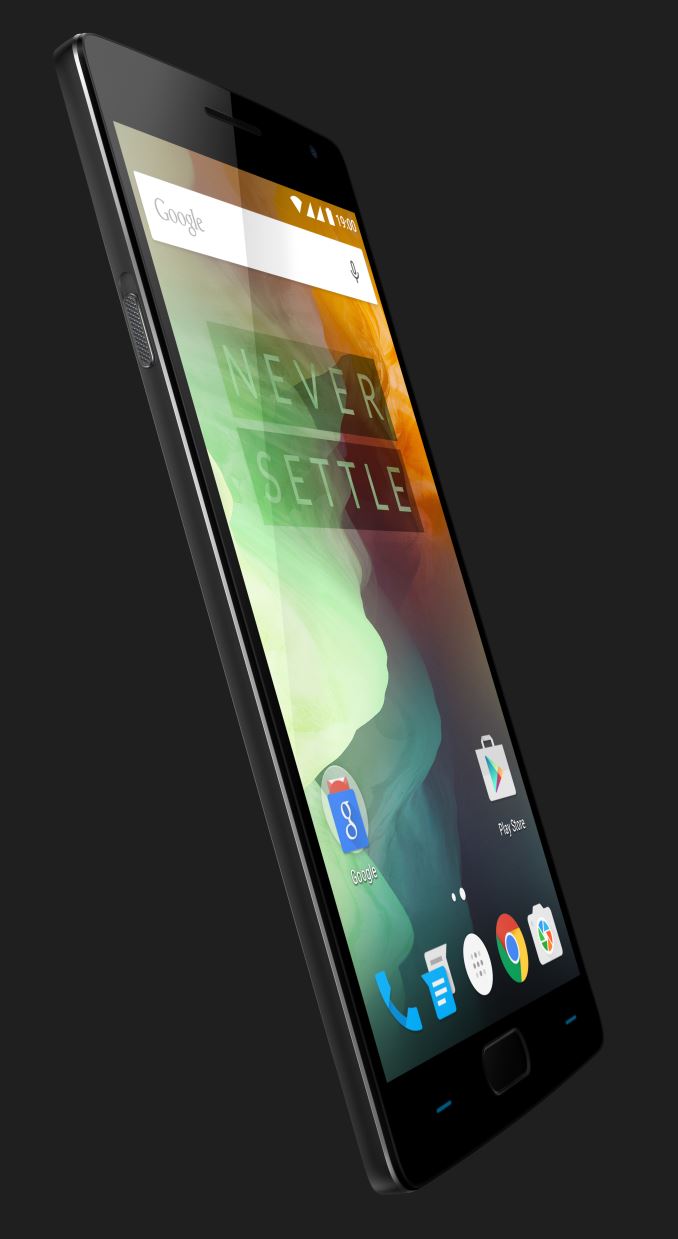OnePlus Announces the OnePlus 2: 389 USD High-End Flagship
by Joshua Ho on July 27, 2015 10:02 PM EST- Posted in
- Smartphones
- Qualcomm
- Mobile
- Snapdragon 810
- OnePlus
- OnePlus 2

OnePlus showed up on the scene last year with a “flagship killer”, the OnePlus One. For those that are unfamiliar with this device, it brought a Snapdragon 801 SoC, 5.5” 1080p display, and some generally impressive hardware at a 350USD price point for the 64GB variant. This made the OnePlus One a pretty incredible value, and to OnePlus’ credit the One remains one of the better choices in the midrange market due to its high-end specs. Today, OnePlus is launching the successor to their first device, which is called the OnePlus 2. To establish some of the basic specifications of this device I would refer to the spec table below.
| OnePlus One | OnePlus 2 | |
| SoC | Snapdragon 801 2.5 GHz Krait | Snapdragon 810 1.8 GHz A57/A53 |
| RAM | 3GB LPDDR3 | 3/4GB LPDDR4-1555 |
| NAND | 16/64GB NAND | 16/64GB NAND |
| Display | 5.5” 1080p IPS |
5.5” 1080p IPS |
| Network | 2G / 3G / 4G LTE (Category 4 LTE) | 2G / 3G / 4G LTE (Category 6/9 LTE) |
| Dimensions | 152.9 x 75.9 x 8.9mm, 162g | 151.8 x 74.9 x 9.85mm, 175g |
| Camera | 13MP Rear Facing (Sony IMX214) f/2.0, 1.1 micron 1/3.06" sensor | 13MP Rear Facing w/ OIS and laser AF, f/2.0, 1.3 micron 1/2.6" sensor |
| 5MP Front Facing | 5MP Front Facing | |
| Battery | 3200 mAh (12.16 Whr) | 3300 mAh (12.54 Whr) |
| OS | Android 4.4 w/ CM11S (At Launch) | Android 5.1 w/ OxygenOS (At Launch) |
| Connectivity | 1x1 802.11a/b/g/n/ac + BT 4.0 (WCN3680), USB2.0, GPS/GNSS, NFC |
802.11a/b/g/n/ac + BT 4.1, USB-C, GPS/GNSS |
| Fingerprint Sensor | N/A | Touch |
| SIM | 1x MicroSIM | DSDS NanoSIM |
| LTE Bands | Global: 1/3/4/7/17/38/40 | US: 1/2/4/5/7/8/12/17 EU: 1/3/5/7/8/20 |
| Launch Price | $299 (3GB/16GB) $349 (3GB/64GB) |
$329 (3GB/16GB) $389 (4GB/64GB) |
As one can see, the display size and resolution is unchanged from the OnePlus One, but OnePlus is promising higher static contrast at 1500:1, relative to the ~1000:1 contrast of the One. This is likely due to the use of photoalignment technology, which seems to have become an industry standard within the past few months. The 1080p resolution is sufficient for a 5.5” smartphone, although an increase to 1440p would be noticeable I suspect that OnePlus is responding to demands for improved battery life over higher display resolutions. The OnePlus 2 also has the somewhat standard Snapdragon 810 for a high-end smartphone, although it’s notable that the maximum frequency of the A57 cluster has been capped to 1.8 GHz in order to improve thermal performance. It isn’t clear if OnePlus is also using hotplug or other mechanisms to only use two big CPU cores either, but this will take a review to really figure out what’s going on. Battery also receives a minor size increase from 3200 mAh to 3300 mAh, presumably at a 3.8V nominal voltage. The lack of microSD expansion likely comes from user experience concerns, as is the non-removable battery. The OnePlus 2 also has a significant improvement to materials, as the frame is an alloy of aluminum and magnesium while the OnePlus One was only made of plastic on the outer casing.
The other major change is the camera. It seems that OnePlus has elected to use a 13MP, 1.3 micron camera sensor with OIS integrated into the module and laser auto focus. The 13MP 1.3 micron sensor is likely to be the OV13860, which means that the sensor format is similar to both the LG G4 and Samsung Galaxy S6, but with a larger pixel size to improve low light performance to reduce read noise from the sensor. Optical stack details remain unknown but the aperture stays at f/2.0 to balance distortion and low light performance. OIS is also introduced to improve low light photo performance for longer exposures. Laser AF is also added to reduce AF speed, a weakness that was present in the OnePlus One. Given the look of this laser AF mechanism, I suspect this is ST-M's time of flight sensor which means that this sytem will be most effective within 10cm of the laser AF sensor.
OnePlus has also introduced some new features in the form of a notification switch, fingerprint sensor, and USB-C port. The notification switch allows for fast switching between all, priority, and no notifications somewhat similar to the iPhone’s mute switch. The fingerprint sensor is also said to be better and faster than the iPhone 6’s TouchID sensor. It’s also purely capacitive, which should make it unlikely to fail over time and you can turn the phone on and unlock it only by using the fingerprint sensor, which would make the experience similar to the HTC One M9+ and Huawei Ascend Mate 7. The addition of USB-C is also great to see, as this makes OnePlus one of the first OEMs to adopt the reversible USB connector standard although it isn’t clear if all of the various features that come with USB-C will be adopted with the launch of Android M.
The OnePlus 2 will be available starting August 11 in select countries for the 64GB storage variant. The 3GB/16GB model will be 329 USD, and the 4GB/64GB model will be 389 USD. StyleSwap covers, which allow you change the back cover’s look and feel, will also be available, with black apricot, Kevlar, bamboo, rosewood, and sandstone black options.














90 Comments
View All Comments
droidzn - Tuesday, July 28, 2015 - link
Oneplus two breaks the border to become the 2016 flagship smartphone. Can't wait to get one here: http://goo.gl/K3AUZeayqazi - Tuesday, July 28, 2015 - link
Non-removable battery, nooooooo! :( I'm never buying a phone with a non-removable battery again, after my experience with the Nexus 4, which now lasts about 4-5 hours between chargesMaxpower2727 - Tuesday, July 28, 2015 - link
Good luck continuing that in the next couple years.hughlle - Tuesday, July 28, 2015 - link
I wonder when companies will wise up to the fact that a hell of a lot of us do not upgrade our phones because we have absolutely no desire for something so large.Impulses - Tuesday, July 28, 2015 - link
Agreed, I could live with it but I really don't care to. Even my Nexus 5 is larger than I'd like, I'd rather have something the size of the original Moto X (and almost bought one).Android OEM *have* to be losing sales by not having decently spec'd mid size flagships IMO (going on two years of this)... AFAIK both iPhones still sell quite well, I'd love to know the actual distribution.
Maybe they think the cross section of people that prefers smaller phones is also fine with low end crap, hopefully they're not right if so...
hughlle - Tuesday, July 28, 2015 - link
Yup. It's just daft. Many of us couldn't care less aobut watching films on their phone or playing 3d shooters or whatnot. Many of us just want a powerful well-equipped phone that fit nicely in your hand. I've an HTC M7 and even that is a bit too large for me. I often pick up my spare HTC desire and feel a sense of loss. My contract is up next month, but not a chance i'll buy a new one or a new phone if my only small options are either a couple of generation old flagships, or mid to low end phones.I work with someone who has a G4 and it is just laughable.
BMNify - Tuesday, July 28, 2015 - link
Sony Z3 compact provides that small phone flagship experience, vote with your wallet and create the segment you want to exist or else you are only proving manufacturer's right, Z3 compact was No.1 seller for many days in Japan.Impulses - Tuesday, July 28, 2015 - link
Z3c was very very tempting, two things kept me from voting with my wallet tho... I'd have to switch carriers for it and I dislike their custom dock rather than just building in Qi. Too much of a hassle, if they come out with a Z4/5c that has OIS at least I might switch carriers for it. Sony's phone division seems to be flailing in the wind tho...BMNify - Tuesday, July 28, 2015 - link
Ultimately you have to make some sacrifice as there is no perfect phone, Qi can be ignored if it comes Qualcomm Quick Charge, the Sony cameras are excellent and regarding carriers as i said earlier: Till the time you remain Telecom carrier slave, you will keep facing such problems, this is a unique USA problem as rest of the world buys any phone and uses it on any network.flyingpants1 - Wednesday, July 29, 2015 - link
>Qi can be ignored if it comes Qualcomm Quick ChargeNo, no it can't. I use Qi now, there's no reason to downgrade to a phone without it. My ideal phone is a Nexus 5 with front speakers and bigger battery. Until I get that, I'm never buying a phone again.